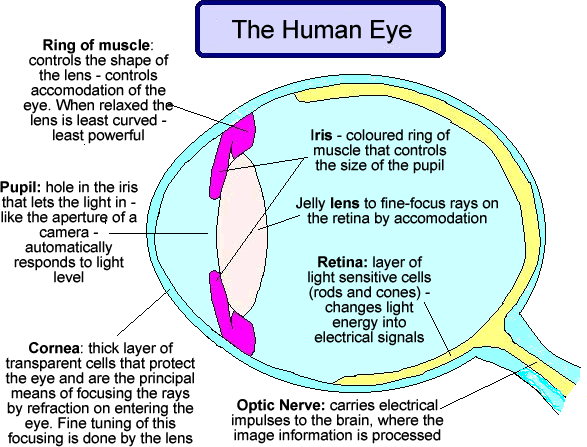The Human Eye
To go to a linked page:
 Vision Defects
Vision Defects
 Correction of Sight Defects - (wearing of glasses or spectacles)
Correction of Sight Defects - (wearing of glasses or spectacles)
 Eye - structure (for A level Physics)
Eye - structure (for A level Physics)
 Eye - photodetector function (for A level)
Eye - photodetector function (for A level)
 Depth of field and depth of focus
Depth of field and depth of focus
The
eye is essentially a closed sphere into which light passes through a
lens and strikes a light sensitive surface. A simplified anatomy of
the eye is shown in the diagram below
You are expected
to be able to label such a diagram and explain the function of each part
of the eye.

You
should also know that:
 the Retina is the coating of the interior
surface at the back of the eye. It consists of an array of light-sensitive
receptors called rods and cones which convert the light energy
into electrical signals. It plays the role of the film in a camera.
the Retina is the coating of the interior
surface at the back of the eye. It consists of an array of light-sensitive
receptors called rods and cones which convert the light energy
into electrical signals. It plays the role of the film in a camera.
 Rods
are sensitive to dim light and do not respond to colour. They allow us to see in dim light conditions.
Rods
are sensitive to dim light and do not respond to colour. They allow us to see in dim light conditions.
 Cones
are sensitive to bright light and colour (blue, red and green).
Cones
are sensitive to bright light and colour (blue, red and green).
When
image is formed on the retina the image is inverted, real, and diminished.
The ability of the eye to form an image on the curved surface of the retina
is extremely important in human vision.
 The blind spot,
located where the optic nerve meets the eye, contains no photo-receptors.
The blind spot,
located where the optic nerve meets the eye, contains no photo-receptors.
 The optic nerve
transmits impulses to the brain. A crossover takes place. The optic nerve
of each eye sends the information to the opposite hemisphere of the brain.
The optic nerve
transmits impulses to the brain. A crossover takes place. The optic nerve
of each eye sends the information to the opposite hemisphere of the brain.
 One eye is usually
dominant, controlling perspective. The use of two eyes (binocular vision)
is necessary to obtain the correct perception of depth.
One eye is usually
dominant, controlling perspective. The use of two eyes (binocular vision)
is necessary to obtain the correct perception of depth.
The brain is capable
of making adjustments and corrections, so in spite of the poor optical
qualities in the human eye (compared to other types of lenses and optical
systems) no optical system yet devised can rival the superb qualities
of human vision!!







